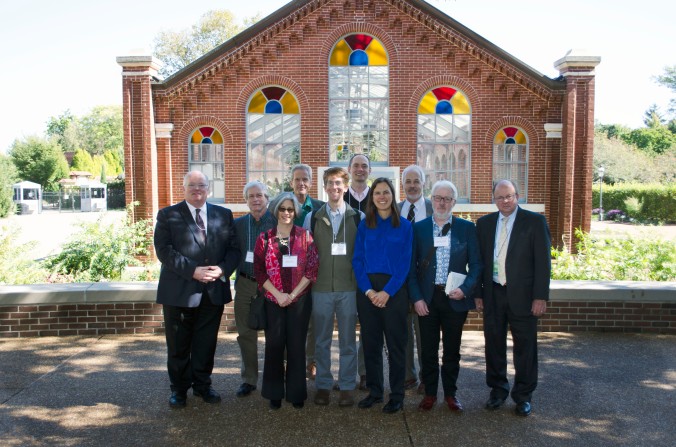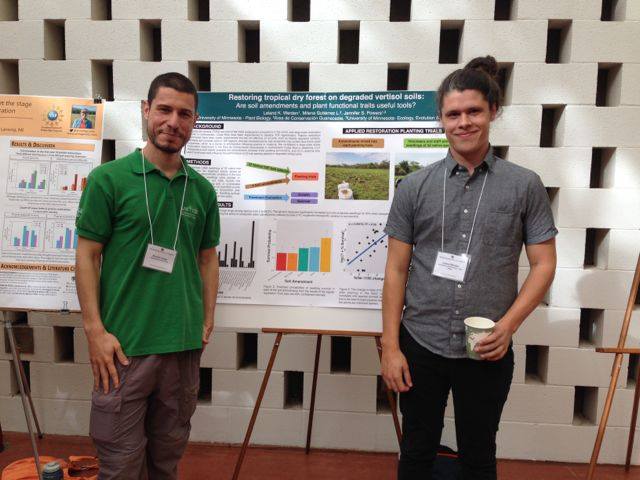If you were at the MBG Fall Symposium, we want to hear from you! How did the symposium change your perception of restoration? Send us an email at leighton.reid@mobot.org.
On October 8th, Missouri Botanical Garden hosted its 63rd annual Fall Symposium. This year’s theme was Ecological Restoration in a Changing Biosphere. Author and journalist Paddy Woodworth moderated the day, and seven speakers presented contemporary perspectives on a core challenge in modern restoration ecology. Namely: in the post-COP21 world, when all three UN conventions call for scaling up and mainstreaming of restoration, it is clear that restoration will affect hundreds of millions of hectares – and as many people – over the coming decade. At the same time, we find ourselves in an era of unprecedented change where climate, ecological baselines, and future land-use changes are highly uncertain. This raises the question: What should large-scale restoration look like in the remainder of the 21st century?

2016 Fall Symposium speakers. From left to right: Peter Wyse Jackson, Curt Meine, Robin Chazdon, James Aronson, Leighton Reid, Pedro Brancalion, Karen Holl, Don Falk, Paddy Woodworth, and Jim Miller. Photo by Andrea Androuais.
Talks during the morning focused on tropical forests, where much of the international restoration dialogue is focused.
- Leighton Reid (Missouri Botanical Garden) opened with a presentation on restoration longevity – the idea that some restoration projects create ecosystems that persist for more than a century (e.g., Floresta da Tijuca), while other projects fail quickly. Dr. Reid argued that how long restored ecosystems persist is quantifiable, predictable, and manipulable, opening the possibility for more ambitious restoration planning.
- Robin Chazdon (University of Connecticut and beyond) then spoke about forest landscape restoration, an approach that aims to regain ecological integrity and enhance human well-being in deforested, human-impacted, or degraded forest landscapes. Drawing on a wealth of large-scale studies, Dr. Chazdon made the case that natural forest regeneration is the most ecologically effective and economically feasible approach to forest restoration globally.
- Karen Holl (University of California Santa Cruz) presented her take on research priorities for forest restoration in the Neotropics. She highlighted that researchers could make an impact by studying forest restoration at larger spatial scales, at longer temporal scales, and in collaboration with stakeholders. Improving information exchange and standardizing monitoring protocols were also among her top priorities. (Graduate students, take note!)
- Dr. Pedro Brancalion (University of São Paulo) completed the morning session with a TED talk-style discussion of the linkages between science, technology, policy, and best practice in Brazilian Atlantic Forest restoration. Using Thomas Kuhn’s structure of scientific revolutions, Dr. Brancalion argued that restoration ecology is in a crisis period, in part because disciplinary research has predominantly created solutions at smaller spatial scales than the (growing) problems the discipline seeks to address. Perhaps restoration is ripe for a paradigm shift?

Dr. Pedro Brancalion (right) asks whether restoration ecology is ready for a new paradigm shift, as Paddy Woodworth (left) moderates. Photo by Robin Chazdon.
After lunch, the conversation turned towards a major academic debate in restoration ecology. Has global change outpaced the restoration approach? And is a new approach needed?
- Curt Meine (The Aldo Leopold Foundation) drew on his long experience in the upper Midwest, and, in particular, his studies of author and environmentalist Aldo Leopold (1887-1948). He argued that Leopold avoided the simple polarities through which some contemporary restoration debates are framed. He viewed nature in a relative way, neither entirely wild, nor entirely domesticated in any given landscape. Although he practiced ecological restoration in some contexts, he also advocated soil conservation and sustainable agriculture – activities motivated by his core values, as expressed in The Land Ethic (1949).
- James Aronson (Missouri Botanical Garden) followed with an elucidation of the reference ecosystem concept. Reference ecosystems, he noted, help determine the social and ecological vision for a restoration project or program – a critical issue for restoring historic continuity in degraded landscapes. Dr. Aronson described a family of restorative actions for achieving progress towards the reference system, drawing on examples from Jordan and South Africa. He argued we need to look deeper into the past and ponder our choices from many angles as we decide how to do more effective restoration at the landscape and larger scales.
- Donald Falk (University of Arizona) delivered the keynote address. He painted a disturbing portrait: rapid climate change is driving a massive forest-to-non-forest transition in the southwestern United States. In particular, many ponderosa pine forests will not be able to persist in the future where they have been in the recent past and present. Perhaps restoration ecologists should transition too. Rather than “chasing the ambulance”, maybe we could get out ahead of disasters and ease transitions between stable ecosystem states. Anticipating ecosystem transitions could mitigate the loss of ecosystem functioning that accompanies major climate-driven forest fires, but it would require a shift in restoration thinking. Importantly, Dr. Falk noted that ecosystems do not care what words we use – ecosystems respond to actions.
With moderator Paddy Woodworth’s help, we finished the day with a panel discussion, inviting questions from the audience. Among the thoughts and questions that we were left with:
- Is ecological restoration more difficult in places with greater population density?
- Should restoration focus on policy, economic, or cultural motivations for engaging people?
- Are values a better guide for land management than ecological history? Are the two complementary?
- How can the reference ecosystem concept accommodate rapid biome changes, as we are seeing in the Southwestern USA?
- What is the way forward to mainstream serious, multisectorial monitoring and evaluation with all these new factors to consider? Who will fund it?
- To what extent can we move from restoring degraded ecosystems to avoiding degradation in the first place?
- Can forest landscape restoration and natural forest regeneration bridge the gap between small-scale, past restoration experience and present, large-scale restoration needs?

PhD candidates Ricardo Cesar (University of São Paulo) and Leland Werdan (University of Minnesota) compare notes on seedling functional traits in dry tropical forest restoration. Leland was the recipient of the annual Delzie Demaree award. Photo by Robin Chazdon.

More than 150 people registered for the symposium. They came from three continents, five countries, and seven US states.
Pingback: Special Feature: Ecological Restoration in a Changing Biosphere | Natural History of Ecological Restoration